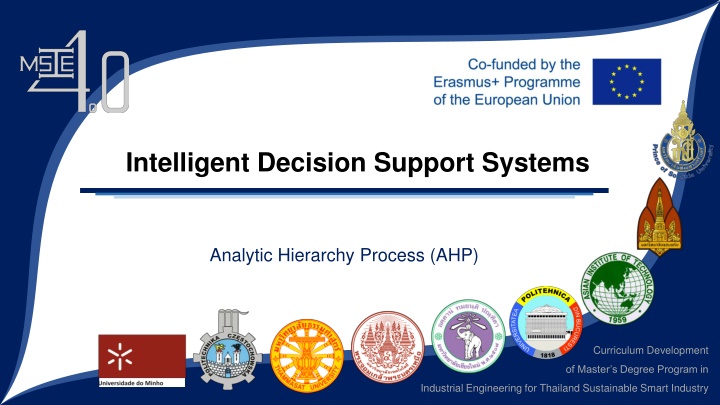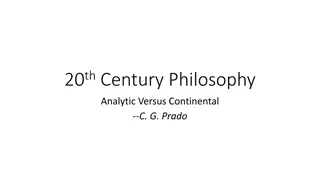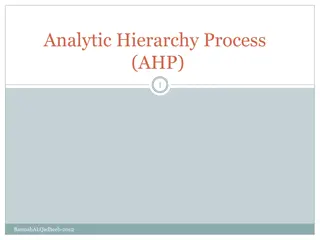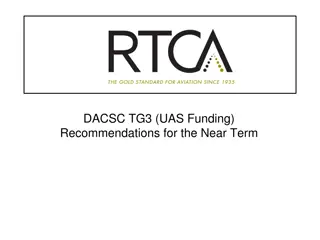Analytic Hierarchy Process (AHP) for Sustainable Smart Industry Curriculum Development
Intelligent Decision Support Systems and the Analytic Hierarchy Process (AHP) play a crucial role in the development of a Master's Degree Program in Industrial Engineering for Thailand's Sustainable Smart Industry. AHP, developed by Thomas Saaty, aids in measuring intangible factors through paired comparisons using human judgments. It provides a structured approach for decision-making by prioritizing factors based on pairwise comparisons, leading to the ranking of alternatives. AHP is valuable in resource allocation, conflict resolution, and decision models involving benefits, opportunities, costs, and risks. Saaty's method brings mathematical precision to multi-dimensional decisions, allowing for the prioritization of factors in a decision-making framework.
Download Presentation

Please find below an Image/Link to download the presentation.
The content on the website is provided AS IS for your information and personal use only. It may not be sold, licensed, or shared on other websites without obtaining consent from the author.If you encounter any issues during the download, it is possible that the publisher has removed the file from their server.
You are allowed to download the files provided on this website for personal or commercial use, subject to the condition that they are used lawfully. All files are the property of their respective owners.
The content on the website is provided AS IS for your information and personal use only. It may not be sold, licensed, or shared on other websites without obtaining consent from the author.
E N D
Presentation Transcript
Intelligent Decision Support Systems Analytic Hierarchy Process (AHP) Curriculum Development of Master s Degree Program in Industrial Engineering for Thailand Sustainable Smart Industry
Module 2: Software Tools for IDSS Development Analytic Hierarchy Process (AHP) R-software RapidMiner WEKA Deep Learning for Smart Production
Analytic Hierarchy Process (AHP) The Analytic Hierarchy Process (AHP) is a theory developed by Thomas Saaty for measuring intangible factors through paired comparisons using judgments from a 1 to 9 fundamental scale and resulting in priorities for the factors. It can be applied to both tangibles and intangibles and is used for decision making by structuring a hierarchical model with a goal, criteria (sub-criteria), and alternatives then making pairwise comparison judgments about the dominance of groups of elements in a level below with respect to the element from which they are connected in the level above. In the end the priorities of all the elements are synthesized to rank the alternatives. These simple hierarchies can be extended to multi-level decision models with hierarchies of benefits, opportunities, costs and risks. The AHP has been applied in many areas including resource allocation and conflict resolution. There are numerous intangibles that have great impact that we must first measure before we can include them as variables. What is most significant is that intangibles can only be measured through expert judgment and only relative to the goals of concern in a particular situation. https://www.superdecisions.com/
Analytic Hierarchy Process (AHP) The Analytic Hierarchical Process (AHP) and the Analytic Network Process (ANP) are used to measure intangibles using human judgment. AHP/ANP are the most powerful synthesis methodologies for combining judgment and data to effectively rank options and predict outcomes. https://www.superdecisions.com/
Analytic Hierarchy Process (AHP) Thomas L. Saaty is the creator of the Analytic Hierarchy Process (AHP), a method for measuring intangibles by making judgments on pairs of elements with respect to a property they have in common. In multi-criteria problems these measures are combined using a hierarchical or network structure to choose the best of several alternatives. By using the AHP, multi-criteria performance measures can be developed to measure the potential benefits of projects and initiatives so that resources can be deployed where they are most likely to achieve the greatest return. The strength of Dr. Saaty's method is its ability to measure intangibles. It brings mathematical precision and science to answer the murky, complex, multi-dimensional decisions that occur during constantly changing conditions. In essence, his method quantifies the value of different choices, and creates a framework in which people can prioritize the factors in a decision without becoming overwhelmed by the tradeoffs. https://www.superdecisions.com/
Analytic Hierarchy Process (AHP) His AHP accomplishes this grand achievement through structuring, prioritization, scenario analysis, and resource allocation. The process helps prioritize decision attributes by using unique pairwise comparisons that derive a numerical value for the alternatives in a decision, prioritizing and ranking them. Dr. Saaty has always been concerned with validating his work, and to that end, he has produced hundreds of validation examples to demonstrate that his pairwise comparison approach is a more accurate method for prioritization than simply assigning ordinal numbers. The Foundation sponsors education, research and software development in advanced methods of decision-making involving the AHP. Of particular interest are group decision-making on societal issues, conflict resolution, and optimizing the allocation of resources for private and government organizations. Thomas L. Saaty generalized the AHP, which is based on hierarchical modeling, to the Analytic Network Process (ANP) for decision-making with dependence and feedback, and the Neural Network Process (NNP) for neural decision processing. The Foundation recognizes and supports educators, authors and practitioners who work in these areas. https://www.superdecisions.com/
Analytic Hierarchy Process (AHP) The most salient current contender is the Analytic Hierarchy Process (AHP). The Analytic Hierarchy Process (AHP), developed by Saaty (1980), uses pairwise comparison questions to elicit a matrix of judgments of the relative preference between each pair of alternatives with respect to each attribute, and a matrix of judgments of the relative importance of each pair of attributes. For each matrix, the eigenvector associated with the maximum eigenvalue is the set of value scores for alternatives or the set of weights for the attributes. These two types of matrices correspond to the transformation of effects into value scales and to the transformation of value scales to a common unit. Saaty's explanation of an underlying theory of judgment for AHP is rejected by those working in the MUT tradition (Dyer 1990) and defended by advocates of AHP (Harker and Vargas 1990). The debate centers on the meaning of weights in AHP and some implications of these meanings: the possibility of rank reversals among previously included alternatives in AHP when additional alternatives are considered, and the problem of assessing weights based on vague notions of importance without regard to units of measure of effects or units of value. https://www.superdecisions.com/
Analytic Hierarchy Process (AHP) Applications of AHP continue to appear in the planning literature. One of the attractions of AHP is that the judgments required seem to be easier to make, but this occurs, at least in part, because the difficulties of nonlinear value transformations, interdependent attributes, and careful consistency among measurement units are submerged and ignored. One of the major dilemmas in multi-attribute decision making is finding techniques that people will use but that do not submerge the actuality of hard tradeoff questions. https://www.superdecisions.com/
Analytic Hierarchy Process (AHP) The AHP was developed by Saaty (1990) in 1980. Ho et al. (2006) found that AHP has been studied extensively and used in a number of applications related to multiple criteria decision making (MCDM) in the last 20 years. Its wide applicability is because of its simplicity, ease of use and great flexibility. It can be integrated with other techniques, for instance, mathematical programming in order to consider both qualitative and quantitative factors, and also some real world resources limitations. This approach, regarding the integrated AHP, can undoubtedly make a more realistic and promising decision than the stand-alone AHP, from Ho et al. (2006) and Schniederjans and Garvin (1997). AHP has also been widely used in the decision-making process by academics and practitioners in Kengpol and Tuominen (2006), Kengpol and O Brien (2001) and Kengpol (2004, 2008). Some publications apply AHP to weight factors such as in Meethom and Kengpol (2008), Chin et al. (2002) and Ho (2008). We select AHP to find the significant weight of each criterion because the outstanding point of AHP is that the weight resulting can deliver a consistency ratio (C.R.) by using pairwised comparison criteria. Saaty (1990) affirms that the consistency ratio value should be less than 0.1, which means the outcome of weight gives a user considerable confidence before using it. A. Kengpol et al. / Int. J. Production Economics 140 (2012) 691 701.
Analytic Hierarchy Process (AHP) The Analytic Hierarchy Process (AHP) is a method of measurement through pairwise comparisons and relies on the judgments of experts to derive priority scales . Rosaria de F. S. M. Russoa*, Roberto Camanh, Procedia Computer Science 55 ( 2015 ), 1123 1132. Information Technology and Quantitative Management (ITQM 2015), Criteria in AHP: a Systematic Review of Literature .
AHP Step The method starts by structuring a decision-making problem as a hierarchy in the form of an upside-down tree where the main goal is placed on top. Partial objectives that meet the main objective are placed at the second level. Each partial objective at the second level can be decomposed into third level objectives, and each set at each level meets the objective of the level to which they are subordinate. These partial objectives are treated as criteria in this text. At a lower level, the alternatives are listed and then compared pairwise according to their contribution to reaching each objective, or criterion, from the lower level. Pairwise comparisons are performed using the method described by Saaty. Jos Eugenio Leal (2019), MethodsX 7 (2020) 100748
AHP Step The following are the steps for the simplified method. 1. Set the main purpose of the decision-making process. 2. Define the secondary objectives that together meet the primary objective at the second level of the structure of priorities. 3. For each objective at the second level, if necessary, define third-level objectives that meet the next higher objective. 4. Define the alternatives to be considered at the lower level. 5. For each element in a level, repeat the following: a Set the element of apparent greater importance with respect to the criterion of the higher level. b Apply formula 4 to calculate the elements of the vector of priorities for the criterion under consideration. 6. Calculate the priorities of each alternative within each criterion ascending in the tree to the main objective.
AHP Step William Ho & Carman Ka Man Lee & George To Sum Ho, Optimization of the facility location-allocation problem in a customer-driven supply chain, Oper Manag Res (2008) 1:69 79.
AHP Structure Problem A. Kengpol et al. / Int. J. Production Economics 140 (2012) 691 701.
Advanced Materials Research Vol. 1125 (2015) pp 613-619 Submitted: 2015-04-27
Advanced Materials Research Vol. 1125 (2015) pp 613-619 Submitted: 2015-04-27
Advanced Materials Research Vol. 1125 (2015) pp 613-619 Submitted: 2015-04-27
Advanced Materials Research Vol. 1125 (2015) pp 613-619 Submitted: 2015-04-27
Advanced Materials Research Vol. 1125 (2015) pp 613-619 Submitted: 2015-04-27
In particular, if a few experts involved in national defense affairs were to participate in evaluating the rules in the rule base, the accuracy of the system would be much better. Furthermore, if the Analytic Hierarchy Process (AHP) approach was used to select key factors, the rules in the rule base would be more precise.
Article Reviews Assignments: Discussion forums























